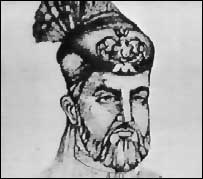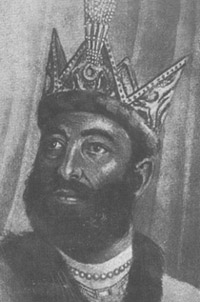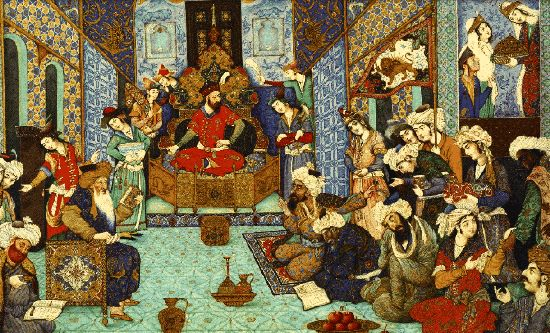Mahmud
Ghaznavi's 17 Invasions of India [Work in
Progress]
Ravi Rikhye
Adapted from Amrit Pal Singhís
listing of Mahmud Ghaznaviís invasions. Please be
welcome should you wish to add to this page. Contact the Publisher should you
wish to take over the page.
This is a non-commercial page maintained in the public interest. We have used images that we believe to be in the public domain. If you own the copyright and do not grant us permission for use, please contact the publisher and we will immediately remove the picture. Other sources ∑ http://www.storyofpakistan.com/person.asp?perid=P042 ∑ http://voi.org/books/mssmi/ch10.htm ∑ http://voi.org/books/tlmr/ch3.htm ∑
http://www.afghanan.net/biographies/mahmudghaznavi.htm ∑
http://www.indhistory.com/somnath-temple.html
∑
http://www.geocities.com/pak_history/ghaznavid.html
∑ Thapar, Romila [2002] Early India; Penguin Books, New Delhi, India.
Background
Until the rise of the west, India was possibly the
richest country in the world. China was a rival in wealth, but we are not
placed to compare the two nations. To the extent that Indiaís climate was
more temperate than Chinaís, and the land probably more fertile, it is likely
India was the richer.
Such a country presented an irresistible target for the
ravening Mongols and their descendents who settled
in present day Afghanistan, Uzbekistan, and Tajikstan,
all within comparatively easy reach of northwestern India.
The northwest was, at this time, a mish-mash of warring
kingdoms, more interested in settling scores with their neighbors than in
unifying against the Mongols. It is then unsurprising that Mahmud Ghaznaviís armies so handily defeated those of the Indian
kings.
Mahmud
Ghanznavi (translated: Mahmud of Ghazni) was not, according to some, like future Muslim invaders
of India, a religious proselytizer. Indeed, with the exception of Punjab,
which he needed as his "forward operating base" for his Indian
expeditions, he made no attempt to rule any of his conquests. His intent was
economic and political. It has been said that the destruction of Somnath is mentioned only in Muslim texts, whose authors
had the habit of exaggeration. This view goes as far as to say in the opinion
of some, the Ghaznivad empire fell apart because of
Mahmudís excessive reliance on Hindu soldiers and generals. †Others, however, have argued the reverse: he may have wanted the money, but also wanted to spread Islam and did his best to destroy temples even when offered large sums to leave the temples alone. The Indian historian Romila Thapar [2002] takes a middle view: Mahmud needed money for his wars; Indiaís temples were known to contain fabulous treasures; we need not look for more complicated explanations. Thapar said he was undoubtedly an iconoclast, and hardly averse to destroying temples to gain favor when he went to heaven. Nonetheless, he warred equally with other Islamic sects, because he was a Sunni. The secondary purpose of his raids may have been tied up with his need to convert Shias to Sunni beliefs. Nonetheless, for our purposes, which are military history, Mahmud Ghaznavi's motives and large aims are irrelevant, and we say without hesitation we have little idea of where the truth lies. Understandably, Indians know Mahmud Ghaznavi because of his invasions of India. But he fought many wars to the west, and captured large parts of today's Iran, and that was an entirely different part of his life. His father was a Turkish slave; this would be one reason he looked to the west. While we have believed, as have most school and college students of Indian history, that there were 17 invasions, some say there were 14. We hope someone with the necessary scholarship can enlighten us on this. MAHMUD GHAZNAVI Born
in 971, Mahmud Ghaznavi was the elder son of Subuktagin, the king of Ghazni.
When Subuktagin attacked King Jaipal,
Mahmud fought for his father in the battlefield. Though Mahmud was the elder
son of his father, it is said that in his last days, Subuktagin
was not happy with Mahmud. So, when Subuktagin died
in 997, his younger son Ismail became the king of Ghazni.
Ismail
reigned only for a little time. Very soon, Mahmud defeated him and became the
king. Mahmud began a series of seventeen raids into northwestern India at the end of the 10th century. Nonetheless, he did not attempt to rule Indian territory except for the Punjab, which was his gateway to India, as Ghazni lay in present day Afghanistan.
http://andrejkoymasky.com/liv/fam/biom1/mahm1.html Invasions [partial list, work in progress] 1000 AD: Indian Frontier Towns
1001-03 AD: Jaipal, Peshawar Jaipal was the king of Hindushahi Kingdom. Mahmud had already fought against
him, when Subuktagin was the king of Ghazni. When Mahmud became the king, he decided to attack
on Hindushahi Kingdom, as its king, Jaipal, was his old enemy. In
1001, Mahmud attacked the Hindushahi Kingdom.
15,000 Hindu soldiers were killed. Jaipal was
defeated and captured. He was presented before Mahmud with his 15 other
relatives; 500,000 enslaved persons were also brought along. Mahmud looted all his wealth. He received 250,000 Dinars to free Jaipal. About 5,00,000 Indians were taken to Ghazni as slaves. Though Jaipal was freed, but he refused to survive his disgrace. He cast himself upon a funeral pyre and died. 1008: Anandpal Anandpal was the son of Jaipal, and now became the king of Hindushahi
Kingdom. In
1008, Mahmud attacked on Anandpal. Anandpal called other Hindu kings to help him. The kings
of Ujjain, Gwalior, Kalinjar, Kannauj,
Delhi, Ajmer etc. came to help him with their armies. In the battlefield of
Peshawar, both the armies remained standing before each other, but no one
attacked. Meanwhile the Khokhars (a race) also came
there to help Hindus. Mahmud deployed 6,000 archers to attack. Khokhars attacked the Muslims and killed approximately
5,000 Muslims. Unfortunately,
Jaipal's elephant became infuriated and ran from
the battlefield. As soon as Jaipal left the
battlefield, the Hindu army got confused and ran away. Muslims chased them
and killed 20,000 Hindus. Thus, the best organized national efforts ever made
by medieval Hindu India against the foreigners ended. 1009: Invasion of Nagarkot [Kangra] Nagarkot was very famous
for its wealth kept in its temples. So, Mahmud decided to invade Nagarkot. Like a swarm of locusts, his army destroyed
everything in its path. Paralyzed
with fear, the defenders opened the cityís gate and fell on the ground in
submission. Mahmud
got so much jewelry, gold and silver, that when he returned to his capital,
his people congregated to see the incredible wealth of India. 1014: Thanesar Mahmud came to know of the riches of Thanesarís temples. In 1014, he invaded Thanesar. The Hindus wanted to reach on a compromise, but Mahmud refused. His army destroyed the city, massacred the inhabitants, and plundered the sacred temples. 1015: Kashmir Valley 1018-19: Mathura and Kannauj When
Mahmud invaded Mathura, he was amazed to see so many huge and beautiful Hindu
temples. No one would resist him, and he entered the city unopposed, leaving
with untold wealth. Then,
he attacked† Kannauj in January of 1019. The King of Kannauj, Rajpal Pratihar did not dare to stop him and ran away. The
invaders looted the sacred temples. Many innocent people were killed. The
king of Kannauj, Rajpal Pratihar accepted the superiority of Mahmud Ghaznavi and then Mahmud turned back for Ghazni. 1021: Kalinjar Rajpal Pratihar, the king of Kannauj,
had accepted the superiority of Mahmud. This made other Rajput kings angry.
The Rajput kings of Kalinjar, Gandda
Chandel, with the king of Gwalior and others
attacked on Kannauj and killed the king Rajpal Pratihar. Mahmud was unhappy with this. To punish the culprits, he attacked Kalinjar. The king, Gandda Chandel accepted the superiority of Mahmud. Mahmud was satisfied with the money the King gave him and he returned. 1023: Lahore 1925: Somnath, 16th Invasion |
|
|


